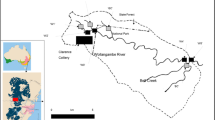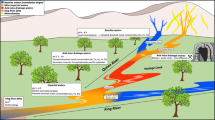Abstract
The environment of deposition of coal-bearing strata not only controls the accumulation of coal seams but also determines the quality of coal deposits. In this study, the thickness and quality parameters of Jangwa-Shankodi and Lafia-Obi coal seams have been investigated and linked to the depositional palaeoenvironmental features. Lithofacies analysis was carried out to deduce the nature of the depositional environment of the coal-bearing strata. Geochemical characterization was performed on eight samples to determine the coal qualities using proximate and ultimate analysis. Nine lithofacies were identified and grouped into two facies associations (FA 1 and FA 2). FA 1 represents several repeated inclined and fining upward units and cycles, with erosional bases and trough cross-stratification, indicating a fluvial regime (meandering river setting). FA 2 consists of thicker deposits of laminated shales and coal seams in a swamp/lagoonal environment. Diminished seam thicknesses in the Jangwa-Shankodi area are due to early termination of peat growth and channel abandonment, whereas relatively thick seam development in the Lafia-Obi area is attributed to regular nutrient supply caused by persistent water coverage as well as high compaction rates of the underlying shaly sediments. The Jangwa-Shankodi and Lafia-Obi coal zones are high volatile C bituminous coal resources with ash, moisture, fixed carbon and volatile matter yield that range between 7.99–8.64% and 7.83–8.34%, 2.33–2.50% and 2.28–2.40%, 55.97–56.14% and 56.18–56.31% and 29.99–30.34% and 29.98–30.22%, respectively. Following the same order, the percentage ranges of elemental carbon and hydrogen are 52.92–53.19% and 53.99–54.52% and 4.47–4.55% and 3.89–4.06%, respectively. Sulphur content was lower in the Lafia-Obi coals (0.08–0.13%). Unlike the Lafia-Obi coals, the close proximity of the Jangwa-Shankodi area to channel and marine influences resulted in a higher sulphur content and ash yield of the coal-bearing strata. This translates to a lesser heating value and coking ability. Better peat growth and preservation points to a higher fixed carbon and better quality for the Lafia-Obi coals. Higher carbon and lower ash yield improve coal reservoir porosity and correlates positively with greater methane absorption capacity. The Lafia-Obi coal field is, therefore, of better quality compared to its Jangwa-Shankodi counterpart.

















Similar content being viewed by others
References
Adekunle JO, Ibrahim JS, Kucha EI (2015) Proximate and ultimate analysis of bio-coal briquettes of Nigerian’s Ogboyaga and Okaba sub-bituminous coal. Br J Appl Sci Technol 7:114–123
Akande S, Hoffknecht A, Erdtmann BD (1992) Rank and petrographic composition of selected Upper Cretaceous and Tertiary coals of Southern Nigeria. Int J Coal Geol 20:209–223
Akinyemi SA, Adebayo OF, Nyakuma BB, Adegoke AK, Aturamu OA, OlaOlorun OA, Adetunji A, Hower JC, Hood MM, Jauro A (2020) Petrology, physicochemical and thermal analyses of selected Cretaceous coals from the Benue Trough Basin in Nigeria. International Journal of Coal Science and Technology 7:26–42
Anyiam OA, Onuorah LC, Okwara IC (2017) Depositional framework and stratigraphy of the Koshisha area, southern Benue Trough. Glob J Geol Sci 15:41–55
ASTM C618 (1992) Manual on drilling, sampling, and analysis of coal. www.astm.org. Accessed 21th Jan 2021
ASTM D3178–89 (2002) Standard testing method for carbon and hydrogen in the analysisof the sample of Coal and Coke. www.astm.org. Accessed 19th Jan 2021
ASTM D5142 (2010) Standard testing method for proximate analysis of the sample of coal and coke by instrumental procedures. www.astm.org. Accessed 20th Jan 2021.
ASTM D7582–15 (2015) Standard test method for gross calorific value of coal and coke by the Adiabatic Bomb Calorimeter. www.astm.org. Accessed 20th Jan 2021.
Benkhelil J (1989) The origin and evolution of the Cretaceous Benue Trough (Nigeria). J Afr Earth Sc 8:251–282
Chaboureau AC, Donnadieu Y, Sepulchre P, Robin C, Guillocheau F, Rohais S (2012) The Aptian evaporites of the South Atlantic: a climatic paradox? Climate of the past 8:1047–1058
Chukwu M, Folayan CO, Pam GY, Obada DO (2016) Characterization of some Nigerian coals for power generation. J Combustion 16:972–982
Cook JM (2015) Stratigraphy, depositional environments, and reservoir characteristics of the Tussy (Desmoinesian) sandstones, southeast Joiner Cityfield, Love and Carter Counties, Oklahoma. Search and Discovery Article No. 20317
Davies-Vollum KS, Zhang Z, Agyekumhene A (2019) Impacts of lagoon opening and implications for coastal management: case study from Muni-Pomadze lagoon, Ghana. J Coast Conserv 23:293–301
Ehinola OA, Ekweozor CM, Oros DR, Simoneit BRT (2002) Geology, geochemistry and biomarker evaluation of Lafia-Obi coal, Benue Trough, Nigeria. Fuel 81:219–233
Ezeh E, Okeke O (2016) Proximate and elemental analysis of some Nigerian coal deposits. British Journal of Environmental Sciences 4:34–38
Farrington JL (1952) A preliminary description of the Nigerian lead-zinc field. Econ Geol 47(583):608
Fielding CR (1985) Coal depositional models and the distinction between alluvial and delta plain environments. Sediment Geol 42:41–48
Flores RM (1983) Basin facies analysis of coal-rich Tertiary fluvial deposits, Northern Powder River Basin, Montana and Wyoming. Mod Anc Fluv Syst 7:499–515
Galloway WE, Hobday DK (1983) Terrigenous clastic depositional systems: applications to petroleum, coal, and uranium exploration. Springer-Verlag, Netherlands
Green I, Ugoji K, Igbere B (2019) Economic analysis of natural gas reserves addition from coal bed methane in Nigeria. Eur J Eng Technol Res 4:31–34
Hagelskamp HB, Eriksson PG, Synman CP (1988) The effect of depositional environment on coal distribution and quality parameters in a portion of the Highveld Coalfield, South Africa. Int J Coal Geol 10:51–77
Hampson GJ (2010) Sediment dispersal and quantitative stratigraphy architecture across an ancient shelf. Sedimentology 57:96–141
Harvey RD, Dillon JW (1985) Maceral distributions in Illinois coals and their palaeoenvironmental implications. International Journal of Coal Geology 5:141–168
Heward AP (1978) Alluvial fan and lacustrine sediments from the Stephanian A and B (La Magdalena, Cinera-Matallana and Sabero) Coalfields, Northern Spain. Sedimentology 25:451–488
Hjellbakk A (1997) Facies and fluvial architecture of a high-energy braided river: The Upper Proterozoic Seglodden Member, Varanger Peninsula, northern Norway. Sedimentary Geology 114:131–161
Holm R, Bell DH (2013) Sedimentology and structure of the Malvern Hills Coal Mine, Canterbury, New Zealand. New Zealand Journal of Geology and Geophysics 56:39–52
Horne JC, Ferm JC, Caruccio FT, Baganz BP (1978) Depositional models in coal exploration and mine planning in Appalachian region. American Association of Petroleum Geologists’ Bulletin 62:2379–2411
Jauro A, Agho MO, Abayeh OJ, Obaje NG, Abubakar MB (2008) Petrographic studies and coking properties of Lamza, Chikila and Lafia–Obi Coals of the Benue Trough. Journal of Mining and Geology 44:37–47
Jauro A, Chukwu CJ (2011) Production of formed coke from Nigerian coals. Petrol Coal 53:22–25
Learning Geology (2015) Barrier and Lagoon Systems: Learning Geology. http://geologylearn.blogspot.com/2015/07/barrier-and-lagoon-systems. Accessed 7 Oct 2021.
McCabe PJ (1985) Depositional environments of coal and coal-bearing strata. Sedimentology of Coal and Coal Bearing Sequences 11:21–42
Miall AD (1996) The geology of fluvial deposits - sedimentary facies, basin analysis, and petroleum geology. Springer Verlag, Berlin
Miall AD (2000) Principles of sedimentary basin analysis. Springer-Verlag, Berlin
Ministry of Mines and Steel. (2008). Ministry of solid minerals investment brochure. www.minesandsteel.gov.ng/wp-content/uploads/2017/10/. Accessed 2nd Feb 2021
Mode AW, Anyiam OA, Okara ES (2018) The use of cross plots in lithology delineation and petrophysical evaluation of some wells in the western Coastal Swamp, Niger Delta. J Petrol Explor Prod Technol 8:61–71
Nichols G (2009) Sedimentology and stratigraphy. John Wiley and Sons, London
NSRMEA (1976) Report on prospection and exploration of Lafia coal deposits in Obi area. Exploration Report-Contact 1717. National Steel Development Authority, Nigeria
Nyakuma BB (2016) Physicochemical characterization and thermal analysis of newly discovered Nigerian coals. Bul Chem Commun 48:746–752
Obaje NG, Ligouis B (1996) Petrographic evaluation of the depositional environments of the Cretaceous Obi/Lafia coal deposits in the Benue Trough of Nigeria. J Afr Earth Sci 22:159–171
Obaje NG (1997) Petrographic evaluation of the coking potentials of the Cretaceous Lafia-Obi coal deposits in the Benue Trough of Nigeria. J Min Geol 43:103–116
Obaje NG (2009) Geology and mineral resources of Nigeria. Springer, Heidelberg, Netherland
Obaje NG, Umar UM, Aweda AK, Ozoji TM (2020) Nigerian Cretaceous coal deposits and their petroleum source rock characteristics. Int J Petrol Gas Explor Manage 4:1–14
Okolo GC, Emedo CO, Obumselu AC, Madukwe FC, Ulasi AN (2020) Lithofacies, particle size analysis and paleodepositional environment of the Eze-Aku Group (Cenomanian-Turonian) in the Itigidi-Ediba area, Afikpo Synclinorium, southeastern Nigeria. J Sediment Environ 5:375–398
Onoduku US (2014a) Chemistry of Maiganga coal deposit, upper Benue Trough, Northeastern Nigeria. J Geosci Geomat 2:80–84
Onoduku US (2014b) Geochemistry of Okaba coal deposit, Anambra Basin, Nigeria. Res J Sci Inf Technol Manage 3:11–16
Petters SW, Ekweozor CM (1982) Petroleum geology of Benue Trough and southeastern Chad basin, Nigeria. Am Asso Petrol Geol Bull 66:1141–1149
Petters SW (1983) Gulf of Guinea planktonic foraminiferal biochronology and geological history of the South Atlantic. J Foramin Res 13:32–59
Petters SW (1991) Regional geology of Africa. Springer Verlag, Berlin
Reading HG (1982) Sedimentary Environments and Facies. Blackwell Science. London
Reading HG, Levell BK (1996) Sedimentary environments: processes, facies and stratigraphy. Blackwell Science, London
Reinson GE (1992) Transgressive barrier island estuarine systems. In: Walker RG, James NP (eds) Facies Models Response to Sea Level Change, Geotext, Canada, pp. 179-194
Rust IC (1975) Tectonic and sedimentary framework of Godwana Basins in southern Africa. In: Campbell KS (ed) Godwana Geology. Australian National University Press, Australia, pp 537–564
Ryemshak SA, Jauro A, Putshaka JD, Sori RM (2016) Ultimate analysis of some Nigerian coal: ranking and suitable application. Int J Eng Appl Sci 3:31–35
Ryemshak SA, Jauro A (2013) Proximate analysis, rheological properties and technological applications of some Nigerian coals. Int J Ind Chem 4:1–7
Seidle J (2011) Fundamentals of coalbed methane reservoir engineering. Pennwell Books, London
Snyman CP, Vna Vuuren MCJ, Barnard JK (1983) Chemical and physical characteristics of South African coal and a suggested classification system. NICR Report-079882799.
Stach E, Mackowsky M, Teichmuller, M, Taylor GF, Chandra G, Teichmuller R (1982) Stach’s Textbook of Coal Petrology. GebrÜder Borntraeger, Germany
Thomas L (2002) Coal geology and use. Wiley Publishing, London
Acknowledgements
The second author wishes to thank the entire academic personnel of the Department of Geology, University of Nigeria, Nsukka, particularly Prof. O. Igwe, Prof. A.W. Mode, Prof. O.A. Anyiam and Dr. O.S. Onwuka, for their support and encouragement during the course of this study. Our sincere appreciation also goes to Prof. Usman Onoduku of the Department of Geology, Federal University of Technology, Minna, for providing guidance and technical input that improved the quality of the final thesis. The National Steel Raw Materials Exploration Agency is acknowledged for the provision of drilling data that aided the analysis of this work.
Author information
Authors and Affiliations
Contributions
Itohowo Moses Ekpo and Johnson Ogonna Amobi conceptualized the project and, along with Chidubem Okwudiri Emedo, participated in data curation, formal analysis, data interpretation and manuscript drafting. Clementina Ogechi Ekwenye and Ifeanyi Andrew Oha provided immense technical support.
Corresponding author
Ethics declarations
Conflict of interest
The authors declare that they have no competing interests.
Additional information
Responsible Editor: Domenico M. Doronzo
Rights and permissions
About this article
Cite this article
Amobi, J.O., Ekpo, I.M., Ekwenye, O.C. et al. Influence of depositional environment on coal quality in Jangwa-Shankodi and Lafia-Obi areas, Central Benue Trough, north-central Nigeria. Arab J Geosci 14, 2614 (2021). https://doi.org/10.1007/s12517-021-08925-z
Received:
Accepted:
Published:
DOI: https://doi.org/10.1007/s12517-021-08925-z




